Welcome to our comprehensive guide to blue birds in Nebraska! With its diverse ecosystems, Nebraska is a haven for bird watchers and nature enthusiasts alike. From the rolling sandhills to the lush river valleys, this state is home to a fascinating variety of bird species, including an array of beautiful blue birds.
Our FREE Photo Guide is designed to help you identify and learn about each one of them. Whether you are a seasoned bird watcher or a beginner looking to start a new hobby, this guide is the perfect companion for your next outdoor adventure. So grab your binoculars and let’s explore the world of blue birds in Nebraska together!
Blue Birds Found In Nebraska
Nebraska is a state of varied landscapes, and this diversity is a key reason for its rich birdlife. The state is located in the Central Flyway, a major migration route for many bird species, which brings a multitude of migratory birds through the region each year. From the grasslands of the Great Plains to the wetlands along the Platte River, provides suitable environments for many different species to breed and thrive. Moreover, the numerous lakes and rivers attract a variety of waterfowl and shorebirds.
Eastern Bluebird
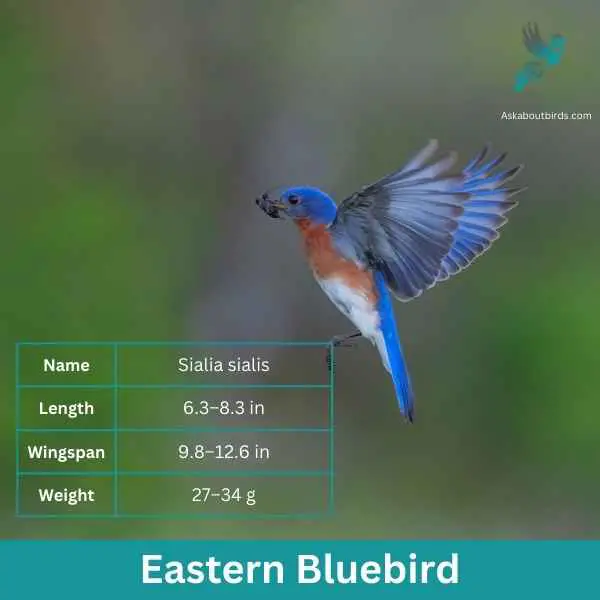
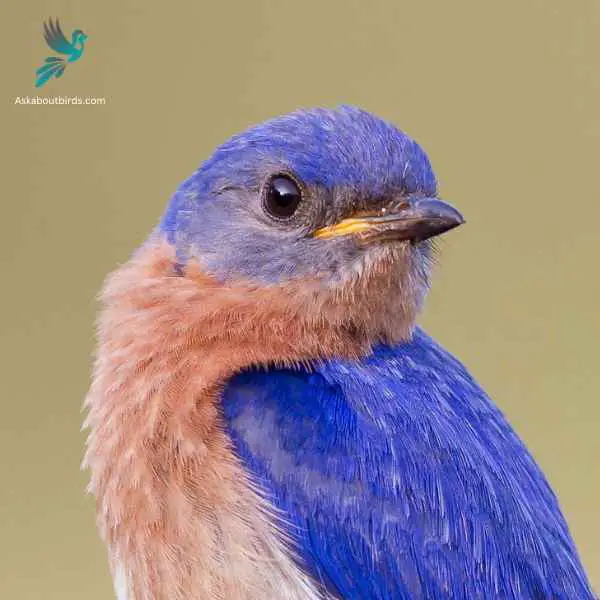
| Feature | Measurement |
|---|---|
| Scientific Name | Sialia sialis |
| Length | 6.3–8.3 in |
| Wingspan | 9.8–12.6 in |
| Weight | 27–34 g |
The Eastern Bluebird (Sialia sialis) is a small thrush found in open woodlands, farmlands, and orchards, and is recognized for its vibrant blue and red coloration. Male Eastern Bluebirds are dazzling with bright blue upperparts and a rusty or brick-red throat and breast, while females, though less colorful, still offer a similar pattern. The bird is native to North America and is commonly seen east of the Rockies, from Canada to the Gulf States and southeastern Arizona to Nicaragua.
Eastern Bluebirds feed on insects, wild fruit and berries. They have a gentle nature and are often seen perched alone or in small groups in the open, scanning the ground for prey. They are cavity nesters and will use old woodpecker holes or birdhouses if they are the right size.
Western Bluebird
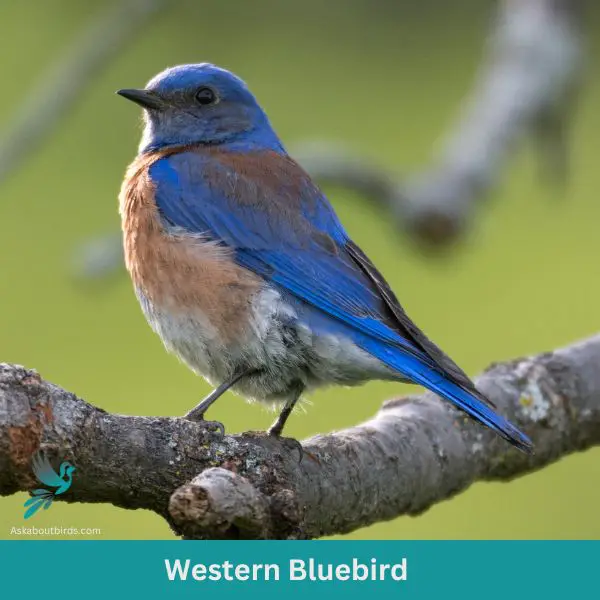
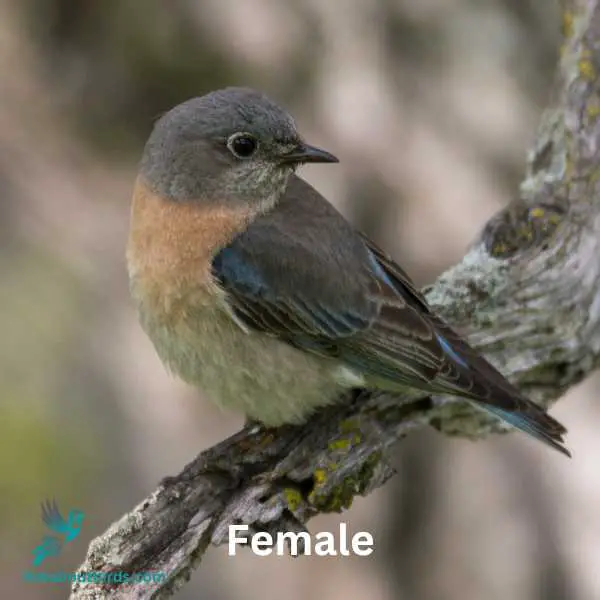
| Trait | Western Bluebird |
|---|---|
| Scientific Name | Sialia mexicana |
| Length | 5.5-7 inches |
| Wingspan | 11-13 inches |
| Weight | 0.8-1.1 ounces |
The Western Bluebird is a charismatic bird, appreciated for its vivid coloring and melodious song, commonly observed in open woodlands and meadows of the West.
Appearance: The male Western Bluebird sports a dark blue head, throat, wings, and tail with an orange breast and sides, transitioning into a grayish belly. Females are more muted, displaying grayish-blue wings and tail with a more subdued orange wash on the chest.
Diet: Western Bluebirds predominantly feed on insects, complemented by berries and fruits when available. They hunt by perching and then diving to the ground to capture their prey, and they’re also known to catch insects in mid-air.
Reproduction: These birds often utilize natural tree cavities or nest boxes for breeding. The female builds a loose nest inside and lays a clutch of 4-6 pale blue eggs.
Mountain Bluebird
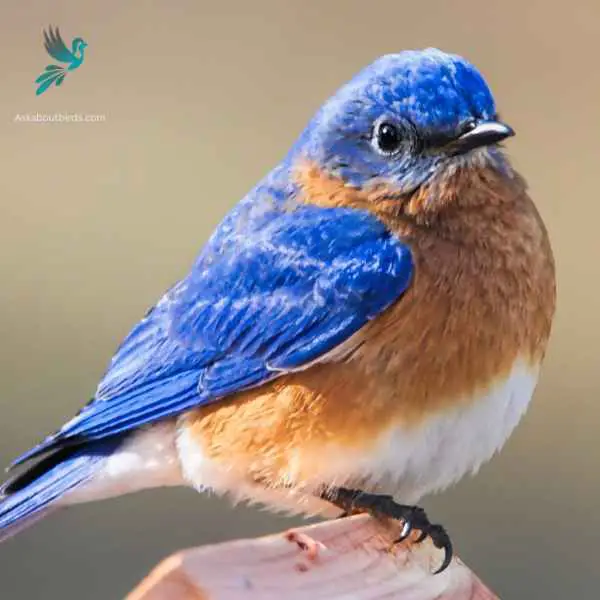
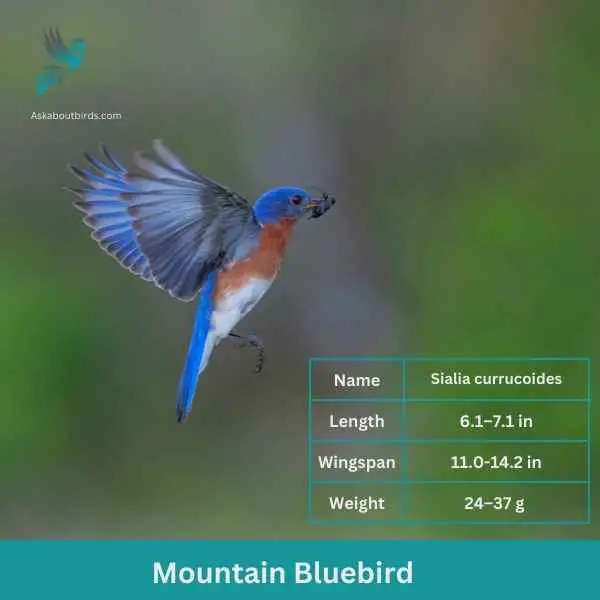
| Feature | Measurement |
|---|---|
| Scientific Name | Sialia currucoides |
| Length | 6.1–7.1 in |
| Wingspan | 11.0-14.2 in |
| Weight | 24–37 g |
The Mountain Bluebird is a small bird found in open grasslands and rocky mountains of North America. It is known for its stunning blue plumage, which is particularly vibrant in males. Females, on the other hand, have a more subdued blue coloration with hints of gray. These birds have slender bodies and a slightly curved bill, adapted for catching insects on the wing.
Mountain Bluebirds are insectivores, feeding primarily on insects such as beetles, grasshoppers, and spiders. They are skilled aerial hunters, capable of capturing their prey in mid-flight. During breeding season, these birds build their nests in tree cavities or man-made nest boxes, where females lay a clutch of eggs. The male bluebird actively participates in nest-building and provides food for the female during incubation.
Blue Jay

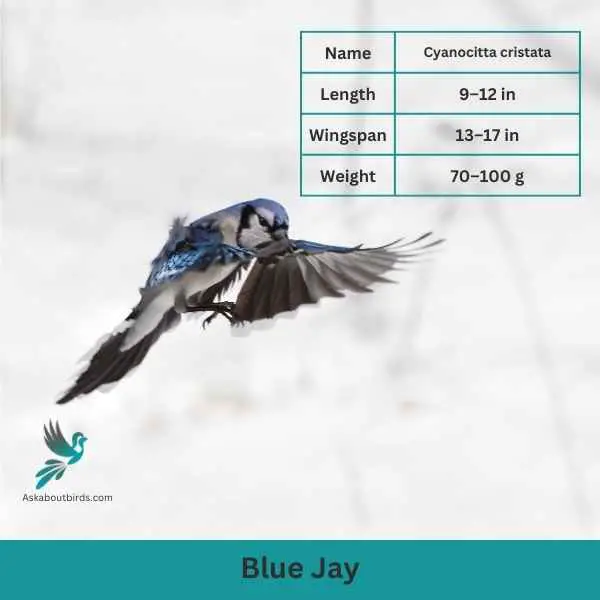
| Feature | Measurement |
|---|---|
| Scientific Name | Cyanocitta cristata |
| Length | 9–12 in |
| Wingspan | 13–17 in |
| Weight | 70–100 g |
The Blue Jay is a vibrant and easily recognized bird, known for its intelligence, distinctive calls, and bold behavior, commonly found throughout the eastern and central United States.
Appearance: The Blue Jay sports a striking blue upper body with white and black markings. Its face has a pronounced white patch with a black necklace that runs across the throat and around the head. The bird also features a pronounced blue crest, which can be raised or lowered, and its wings and tail are brightly colored with black bars and white tips.
Diet: Blue Jays are omnivores. Their diet consists primarily of seeds, nuts, especially acorns, fruits, and small insects. They’ve also been known to eat eggs or nestlings of other birds occasionally. Blue Jays often store food items in caches to eat later.
Reproduction: Blue Jays are monogamous birds that form long-lasting pair bonds. They typically build their nests in trees or large shrubs, constructing them from twigs, grass, and sometimes using mud as a binder. The female lays a clutch of 3 to 6 eggs, which are pale blue or sometimes white with brown speckles.
Indigo Bunting


| Feature | Measurement |
|---|---|
| Scientific Name | Passerina cyanea |
| Length | 4.5–5.1 in |
| Wingspan | 7.1–9.1 in |
| Weight | 11.2–21.4 g |
The Indigo Bunting is a strikingly vibrant songbird, often hailed for its brilliant blue plumage and melodic song that graces woodlands and meadows during the warmer months.
Appearance: Males are renowned for their bright indigo blue feathers, which can appear darker in certain lights. Females and juveniles, on the other hand, are brown with subtle hints of blue on their wings and tail. The species lacks the vibrant streaking or spotting commonly found in many other songbirds.
Diet: Indigo Buntings primarily subsist on seeds, especially during non-breeding seasons. During the breeding season, they also consume a variety of insects such as beetles, caterpillars, and spiders, providing essential protein for their growing chicks.
Reproduction: Indigo Buntings build their nests close to the ground in shrubs or low tree branches. These nests, crafted meticulously with grasses and other plant materials, cradle clutches of typically 3 to 4 eggs. After hatching, the young are fed by both parents until they’re ready to fledge.
Blue Grosbeak
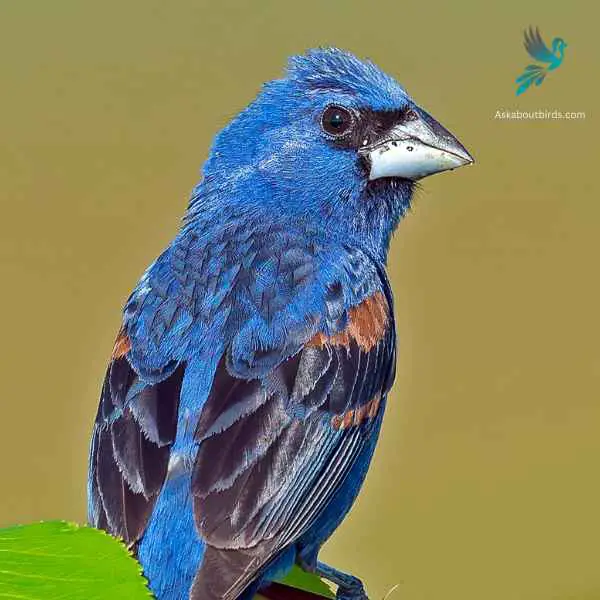

| Feature | Measurement |
|---|---|
| Scientific Name | Passerina caerulea |
| Length | 5.5 to 7.5 in |
| Wingspan | 10 to 11 in |
| Weight | 26 to 31.5 g |
The Blue Grosbeak is a medium-sized songbird found in North and Central America. The male Blue Grosbeak displays stunning plumage with deep blue feathers on its body and head, while the female has more subdued brownish tones. Both sexes have a thick, conical bill, which gives them their name “grosbeak,” meaning large beak.
These birds prefer open habitats such as grasslands, brushy areas, and woodland edges. Blue Grosbeaks are known for their melodious songs, which consist of a series of rich and varied notes. They primarily feed on seeds and insects, using their strong beaks to crack open seeds and forage on the ground or in low vegetation.
Belted Kingfisher

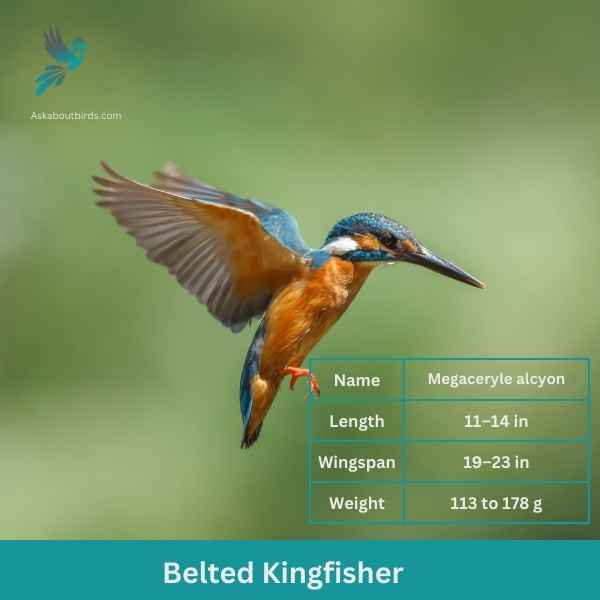
| Feature | Measurement |
|---|---|
| Scientific Name | Megaceryle alcyon |
| Length | 11–14 in |
| Wingspan | 19–23 in |
| Weight | 113 to 178 g |
The Belted Kingfisher is a distinctive and easily recognizable bird, frequently observed near water bodies, where it can be seen diving headfirst to catch prey.
Appearance: Sporting a prominent crest, the Belted Kingfisher has a slate blue-gray upper body and white underparts. Males possess a single blue band across their white chests, while females have an additional rufous band, making them one of the few bird species where females are more brightly colored than males. Their bill is long, sharp, and dagger-like.
Diet: As expert fishers, Belted Kingfishers mainly prey on small fish, but they’ll also consume crustaceans, insects, and amphibians. They’re known for their hunting tactic of hovering over water, spotting their prey, and then diving swiftly to snatch it.
Reproduction: Belted Kingfishers nest in burrows which they excavate in sandy or earthen banks, usually adjacent to water. The tunnel can be anywhere from 3 to 6 feet long, ending in a chamber. Within this chamber, the female lays a clutch of 5 to 8 white eggs.
Tree Swallow
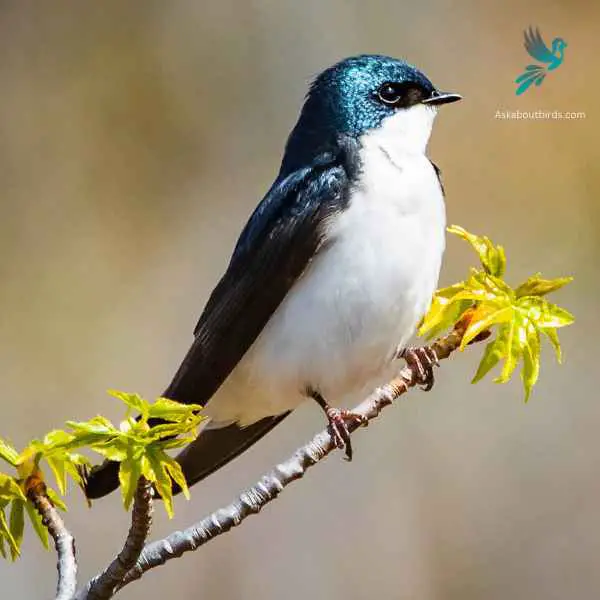
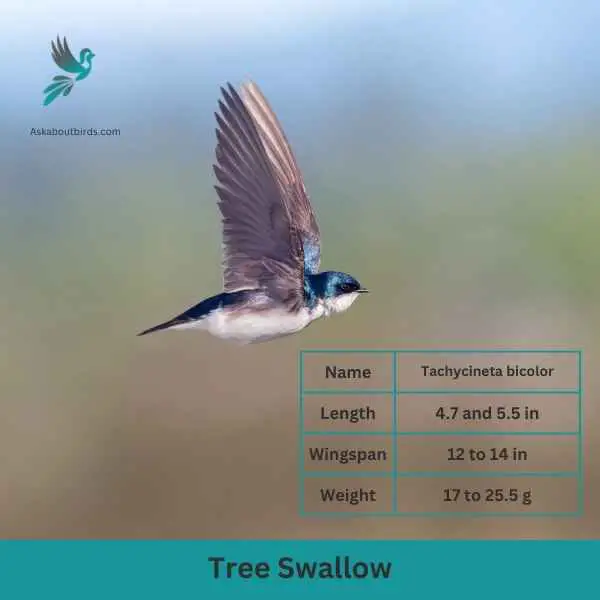
| Feature | Measurement |
|---|---|
| Scientific Name | Tachycineta bicolor |
| Length | 4.7 and 5.5 in |
| Wingspan | 12 to 14 in |
| Weight | 17 to 25.5 g |
The Tree Swallow is a graceful and agile bird, best recognized for its iridescent blue-green upperparts and sweeping flight patterns over open fields and water.
Appearance: The Tree Swallow is sleek with a streamlined body. The upperparts shine with a blue-green iridescence while the underparts are white. They possess long, pointed wings and a slightly forked tail, aiding in their agile flight.
Diet: Tree Swallows primarily feed on flying insects, skillfully catching them mid-air. During colder months when insects are scarce, they can switch to a diet of berries, particularly those of the bayberry, which other birds might find hard to digest.
Reproduction: Tree Swallows are cavity-nesters, typically choosing natural holes in trees or using bird boxes. They line their nests with feathers, creating a soft environment for the eggs. The female will lay a clutch of 4 to 7 white eggs.
Barn Swallow


| Feature | Measurement |
|---|---|
| Scientific Name | Hirundo rustica |
| Length | 6.5–7.5 in |
| Wingspan | 12.5–13.5 in |
| Weight | 16–22 g |
The Barn Swallow is a sleek, agile bird renowned for its graceful flight patterns and iconic forked tail, often seen darting over fields and water bodies in search of flying insects.
Appearance: Barn Swallows have deep blue, almost iridescent, upperparts and a rufous to tawny underbelly. Their distinctively forked tail and long wings give them a streamlined look. Both males and females have a similar appearance, though males often exhibit slightly brighter colors and a deeper fork in the tail.
Diet: Barn Swallows feed primarily on flying insects, which they catch in mid-air during their agile and acrobatic flights. Their diet includes flies, beetles, moths, and other small flying insects.
Reproduction: Barn Swallows are known for building their mud nests on man-made structures, particularly barns, bridges, and eaves. The nest is cup-shaped and made from mud pellets, often lined with feathers. The female lays a clutch of 4 to 6 eggs.
/Violet-green Swallow
Scientific Name: Tachycineta thalassina
Length: 4.7-5.1 in (12-13 cm)
Wingspan: 9.8-11.4 in (25-29 cm)
Weight: 0.4-0.6 oz (11-17 g)
The Violet-green Swallow is a small, agile bird known for its vibrant coloring and acrobatic flight skills.
Appearance: The male Violet-green Swallow has a bright, iridescent green back and head, and violet-blue wings and tail. The face, sides of the rump, and underparts are white. The female has a similar but duller coloration, with less iridescence on the back and head, and often a brownish tinge on the face and flanks.
Diet: Violet-green Swallows primarily feed on flying insects, which they catch in the air during their acrobatic flights. Their diet includes a wide variety of insects such as flies, wasps, ants, and beetles.
Reproduction: Violet-green Swallows typically nest in tree cavities, building nests, or cliff crevices. They often use old woodpecker holes or nest boxes provided by humans. The female lays a clutch of 4 to 6 white eggs, and both parents take turns incubating the eggs and feeding the chicks once they hatch.
/Purple Martin
Scientific Name: Progne subis
Length: 7.5-9.1 in (19-23 cm)
Wingspan: 15.3-16.1 in (39-41 cm)
Weight: 1.9-2.3 oz (55-65 g)
The Purple Martin is a popular and widely recognized bird species, known for its acrobatic flight and social behavior.
Appearance: Purple Martins have a dark, glossy purple-blue plumage. Males are almost entirely dark purple while females and young birds have a lighter, greyish belly and throat.
Diet: The diet of Purple Martins primarily consists of flying insects such as beetles, flies, dragonflies, and moths. They catch their prey in mid-air while flying.
Reproduction: Purple Martins nest in colonies, often using artificial nest boxes provided by humans. The female typically lays a clutch of 4 to 6 white eggs, and both parents participate in incubating the eggs and feeding the chicks.
Cerulean Warbler
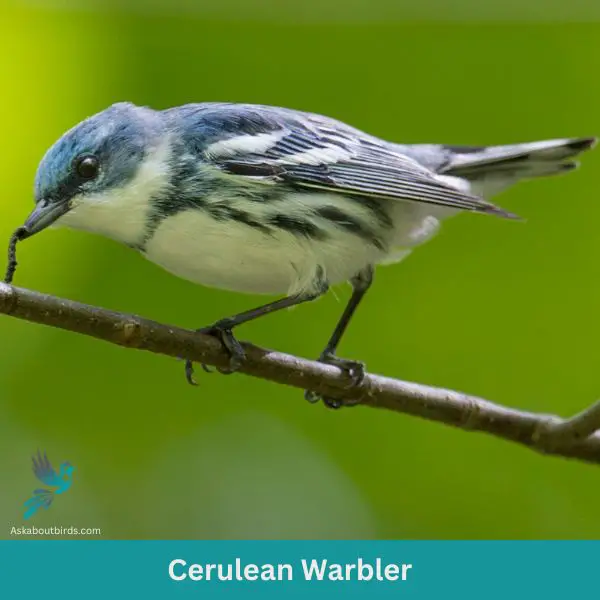
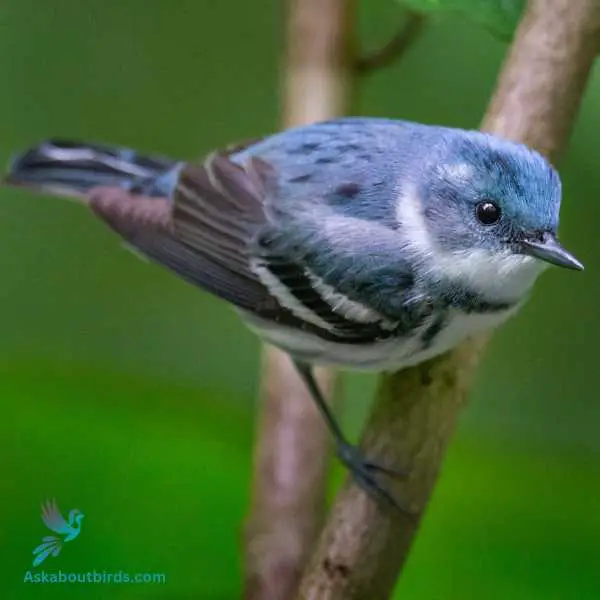
| Trait | Cerulean Warbler |
|---|---|
| Scientific Name | Setophaga cerulea |
| Length | 4.5 inches |
| Wingspan | 7.9-8.7 inches |
| Weight | 0.3-0.4 ounces |
The Cerulean Warbler is a striking songbird known for its sky-blue plumage and flitting movements in the forest canopy.
Appearance: Males boast a vibrant cerulean blue color on their upperparts, with streaked underparts, and a black necklace. Females have a more subdued bluish-green hue and lack the prominent black markings seen in males.
Diet: The diet of the Cerulean Warbler is predominantly made up of insects and spiders. They actively forage high in the treetops, gracefully maneuvering through leaves and branches.
Reproduction: Cerulean Warblers nest in the upper branches of tall deciduous trees. The female weaves a shallow cup-shaped nest and lays a clutch of 3-5 eggs.
Little Blue Heron
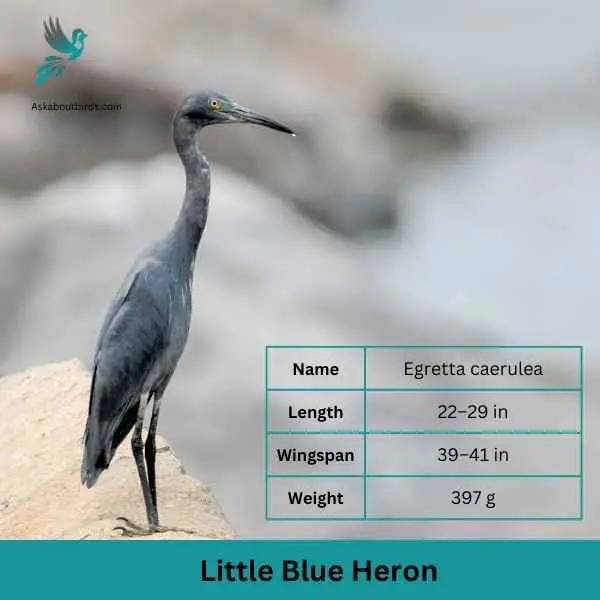
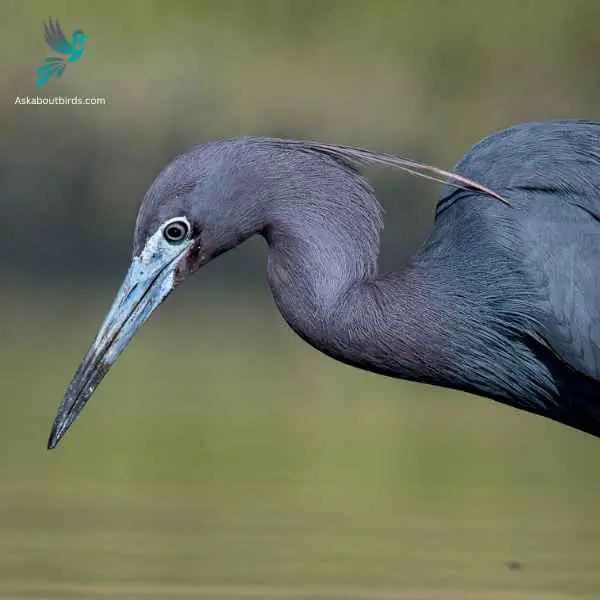
| Feature | Measurement |
|---|---|
| Scientific Name | Egretta caerulea |
| Length | 22–29 in |
| Wingspan | 39–41 in |
| Weight | 397 g |
The Little Blue Heron is a slender and elegant wading bird, often seen foraging in freshwater or saltwater habitats, especially in the southeastern parts of the United States.
Appearance: This heron undergoes a fascinating color transition as it matures. Juvenile Little Blue Herons are white, but they gradually acquire the slate-blue plumage that characterizes adults. The adult has a dark blue-gray body with a purplish neck and head. Their bill is grayish with a black tip.
Diet: The diet of the Little Blue Heron consists mainly of small fish, but they also feed on crustaceans, insects, and other small aquatic animals. Using stealth, they slowly stalk their prey in shallow waters before striking with their long, sharp bill.
Reproduction: Little Blue Herons nest in colonies, often with other wading birds. They build platform nests in trees or shrubs close to water bodies. The female typically lays a clutch of 3 to 5 pale blue eggs. Both parents participate in incubation and feeding the chicks once they hatch.
Where to Spot Nebraska’s Blue Birds
Nebraska offers a wealth of birdwatching opportunities, thanks to its diverse habitats and central location along a major migratory route. For those particularly interested in blue birds, there are several locations across the state that are especially rewarding.
- Rowe Sanctuary, Kearney: Located along the Platte River, this sanctuary is a haven for all sorts of bird species, including bluebirds. During spring and fall migrations, it is an especially bustling spot.
- Fontenelle Forest, Bellevue: This forested area offers a mix of woodland and wetland habitats, making it ideal for spotting a range of bird species, including several types of bluebirds.
- Indian Cave State Park, Shubert: With its mix of mature hardwood forests, this state park is a perfect habitat for bluebirds and other woodland species.
- Bessey Ranger District, Halsey: Located in the Nebraska National Forest, this area is home to the largest hand-planted forest in the United States and is a great spot to observe a variety of bluebirds.
- Smith Lake Wildlife Management Area, Rushville: This location offers a mix of habitats, including sandhills, wetlands, and grasslands, making it a great spot to see a wide variety of bird species, including bluebirds.
| Neighboring State | Best Spots for Blue Birds |
|---|---|
| South Dakota’s Blue Birds | 1. Bear Butte State Park 2. Newton Hills State Park 3. Good Earth State Park |
| Wyoming’s Blue Birds | 1. Medicine Bow National Forest 2. Grand Teton National Park 3. Bighorn National Forest |
| Colorado’s Blue Birds | 1. Rocky Mountain National Park 2. Pawnee National Grassland 3. San Isabel National Forest |
| Kansas’s Blue Birds | 1. Quivira National Wildlife Refuge 2. Cheyenne Bottoms Wildlife Area 3. Tallgrass Prairie National Preserve |
| Iowa’s Blue Birds | 1. Loess Hills State Forest 2. Neal Smith National Wildlife Refuge 3. Lake Red Rock |
| Missouri’s Blue Birds | 1. Mark Twain National Forest 2. Mingo National Wildlife Refuge 3. Shaw Nature Reserve |
FAQs on Blue Bird Species Found in Nebraska
How can I protect bluebird nests from house sparrows?
House sparrows can be quite aggressive and often compete with bluebirds for nesting locations. To protect bluebird nests from house sparrows, it is recommended to place nest boxes at least 300 feet away from buildings and areas where house sparrows are commonly found. Additionally, using a nest box with an entrance hole that is 1.5 inches in diameter will allow bluebirds to enter while excluding larger birds like house sparrows. Regular monitoring of the nest box can also help manage any house sparrow attempts to take over the nest.
How can I attract nesting bluebirds to my backyard?
To attract nesting bluebirds to your backyard, it’s essential to provide them with a suitable habitat. Install a bluebird-specific nest box, as it’s one of the bluebird’s special favorite places to nest. Place the nest box in open spaces or near the edge of woodlands, as bluebirds prefer a mix of trees and open areas. Additionally, providing a bird feeder with their favorite food like sunflower seeds, peanut butter mixes, and raisins soaked in hot water can also help attract them.
What is the breeding range of the Indigo Bunting?
The breeding range of the Indigo Bunting primarily covers the eastern half of the United States, extending into Canada, and reaching as far west as central Texas and the Great Plains. Range maps from the Cornell Lab can provide a more detailed view. These blue beauties can be found in a variety of habitats, including open areas, suburban areas, and edges of woodlands during the summer.
Where can I find barn swallows during their migration?
Barn swallows are commonly found across North America during their migration. They typically head north to their breeding range in North America during the summer, after spending the winter in Central and South America. During their migration, they can be spotted in open areas, over water bodies, and even in suburban areas and city parks.
